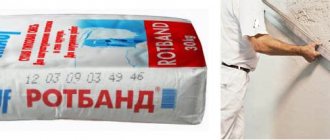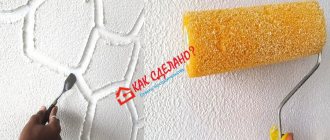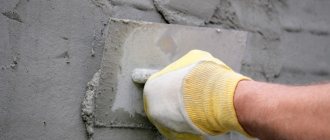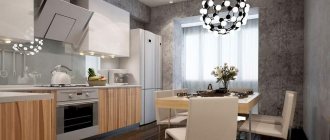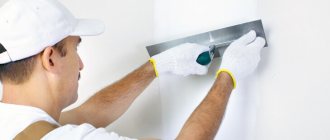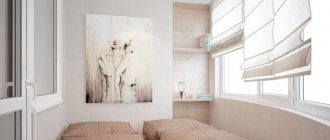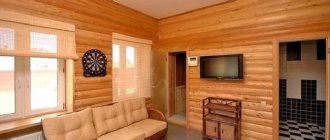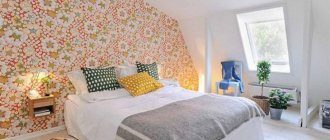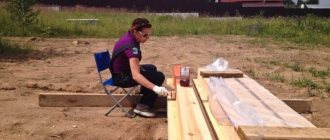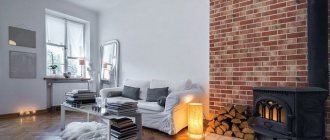| Place | Name | Characteristics in the rating |
| TOP 10 best decorative plasters |
| 1 | VGT | The best choice. A wide range of |
| 2 | Initiatives Decoration | The most expensive plaster with natural stone |
| 3 | LAKRA | Best price with high quality |
| 4 | Quick-mix MODELLIERPUTZ | Simple modeling plaster |
| 5 | Dufa MODELLIERPUTZ | Reliable manufacturer |
| 6 | Dali-Decor | Popular brand |
| 7 | Finncolor Mineral Decor | The best mineral plaster |
| 8 | Optimist-Elite D 727 | The most unusual texture |
| 9 | Perel Acrilico | Texture base for color |
| 10 | Aura Dekor Putz | Decorative plaster for budget renovation |
Photos in the interior
Below we will talk about how decorative plaster is used for interior wall decoration. Read reviews and interior photos about this below.
Kitchen
The use of decorative plaster in the kitchen is an ideal solution for practicality and variety of design. Plaster is a wear-resistant, waterproof material that, if damaged, can be easily repaired. A variety of textures and colors allows you to choose the finish for any style of room.
Corridor
The corridor performs an important function in the house and is the first to take on all weather changes, so it is important to be able to clean the surface of the hallway walls. Decor. plaster is ideal for such purposes. When selected correctly, the material can be cleaned with a brush and a mild cleaning agent without fear of damaging the wall surface.
Balcony
By choosing to decorate your balcony with decorative plaster, you provide yourself with additional insulation of the room and sound insulation. Finishing with plaster will ensure ease of maintenance of the room and resistance to mechanical damage, and if any do occur, it is easier to eliminate them - you just need to dilute a small amount of the same plaster and cover up the defect.
Bedroom
When renovating an apartment, the question always arises as to what material is best for finishing the walls and what material is more suitable for decorative finishing. For a bedroom, the determining criteria, in addition to ease of maintenance and aesthetic beauty, are the environmental friendliness and durability of the coating. This plaster meets all these criteria, and the many different ways of applying it provide enormous scope for room design.
Selecting ready-made formulations
Choosing the type of plaster - gypsum or cement - is just the beginning. Next, you will have to choose the manufacturer and the composition itself - there may be several products with slight differences.
There are many different brands of plaster in construction stores.
The most popular gypsum plaster is Rotband from Knauf. This is a really high quality product that is easy to use even for beginners. The same company has other products - Goldband and HP Start. They are cheaper, and the quality is quite decent.
The most popular type of plaster is Rotband.
NR Start is a gypsum-lime composition, Goldband is a gypsum composition. The difference between Rotband and Goldyuand is the thickness of the minimum layer. Rotband’s is 5 mm, the second’s is 8 mm. Otherwise, the technical characteristics are very similar - both consumption (8.5 kg/m3 with a layer thickness of 1 cm), and maximum layer (50 mm), and compressive and bending strength.
| Name | Purpose | Color | Layer thickness | Binder type |
| Knauf Rotband plaster mixture | For plastering smooth surfaces of walls and ceilings | White gray | 5-50 mm | Gypsum with polymer additives |
| Plaster-Adhesive Mixture Knauf Sevener | For restoration of old plaster surfaces, including facades | Grey | Portland cement with polymer additives and reinforcing fibers | |
| Plaster Bergauf Bau Interier | For plastering in rooms with normal humidity | Grey/White | 5-40 mm | Cement with polymer additives and perlite filler |
| Plaster Volma-Canvas | For indoor spaces with normal humidity | 5-50 mm | Based on gypsum with chemical and mineral additives |
Volma Layer, Osnovit Gipswell, Eunice Teplon, and Prospectors also speak well of gypsum plaster. They cost less, give good results, but it’s still easier to work with Rothband and the “company”. Based on the results of working with these brands, there are both positive and negative reviews, but in general, the quality is not bad.
Cement plasters are available for manual and machine application. We will talk about compositions for manual application. For interior work, Forward, Weber Vetonit, Osnovit Startwell, Weber Stuk Cement are good. They fit well on a clean, pre-moistened surface. For better adhesion, it is better to pre-prime the walls and, after drying, begin the plastering process itself.
Cement plaster is also noticeably different
If you choose cement-based plaster for exterior work (including for plastering an open loggia or balcony), you need façade compounds. They differ from ordinary ones in the increased number of freezing/unfreezing cycles. Facade cement plasters - Yunis Silin facade, Osnovit Profi Startwell, Knauf Unterputz, Bergauf Bau Putz Zement. Ceresit CT 24 Light plaster is suitable for both facade and interior work.
Read more: 10 best nail polishes for strengthening nails
Aerated concrete walls require special plaster. It has increased vapor permeability to prevent moisture from being trapped inside the wall. This is Ceresit CT 24, Knauf Grundband (contains the smallest particles of polystyrene foam, which increases its thermal insulation properties and reduces consumption).
Pros and cons of decorative plaster for interior wall decoration
Like any material, plaster has many pros and cons. Let's take a closer look at them.
- the work requires a minimum number of tools (roller or spatula);
- additionally insulates the wall;
- hides wall defects;
- environmentally friendly material;
- It does not require special care.
- special skills are required to apply plaster;
- easily subject to mechanical damage.
Features of gypsum coatings
It is a dry powder mixture. It consists of several components:
- main – fine-grained gypsum;
- plasticizers;
- polymer additives.
To obtain a mortar from them, you need to add the last component - water, which is taken in a certain ratio to the dry mixture.
Due to its main component, gypsum plaster hardens much faster than its analogues. At the same time, gypsum does not react to drafts, humidity and temperature changes. The hardening period of the mixture will depend on its chosen type. Setting can occur from several minutes to half an hour.
Structural plaster for interior work, photos, as well as the execution diagram are given in the article.
In addition to the main binding ingredient, there are mineral plasticizers, which are responsible for the stability of the solution to changes in volume and shape, as well as improving its plasticity. The last property is very important when applying plaster; the uniformity of application of the material depends on it.
Polymer modifiers improve the interaction of the gypsum solution with the treated surface. They improve the strength of the plaster, its impermeability and elasticity.
The article addresses the issue of warm plaster for the facade, its price and other characteristics.
Let's start by listing its positive aspects:
- perfectly levels out curvature and other unevenness of walls;
- is an environmentally friendly material. It is not aggressive and does not emit toxic substances;
- gypsum plaster is a porous material. Thanks to this, it conducts moisture and steam well. Surfaces treated with it will not absorb moisture and mold will not appear on them;
- the low weight of the solution allows you to reduce the consumption of the mixture and reduce the load on the surface of the building, which is especially important for load-bearing walls;
- gypsum has a high level of noise and heat insulation. These properties are relevant for residents of high-rise buildings;
- the material is not subject to shrinkage, when it hardens, cracks are excluded and therefore there is no need for finishing;
- has good quality and is universal in use;
- high finishing speed. Complete hardening of the composition on the walls occurs in three days, if very thick layers are used, then a maximum of a week;
- plasticity and viscosity. Application of the solution does not require a reinforced mesh; even without it, it adheres well to the surface. Even if a thick layer of plaster is required, it will not spread or peel.
Decorative plasters for interior decoration, photos and other characteristics can be seen and read in this article.
The negative aspects of using gypsum plaster include:
- for some, the price of the material is high, but it is justified by the ease of use, low material consumption and speed;
- difficult to apply to metal surfaces;
- It is not recommended for rooms with high humidity, therefore, such plaster cannot be used in toilets and bathrooms if it is a regular and not a moisture-resistant variety.
Types of plasters for interior decoration, photos and other characteristics can be seen and read in this article.
Application area
It is applied indoors to walls and floors, which can be made of brick or concrete. She is involved in interior decoration before applying paint or wallpapering. The rooms must be dry; if the humidity exceeds 70%, the solution may swell and begin to fall off over time. But if you are thinking about which putty to choose for drywall, then this material may not be suitable.
Warm plaster for interior work, the price for one bag and other characteristics of the bulk material can be found out by reading the article.
It is not advisable to use the gypsum mixture outdoors. Most often it is used for bedrooms and living rooms, especially in those rooms where there are hard-to-reach places.
This article describes whether drywall or plaster is cheaper.
Application to walls
First, you need to prepare the solution, observing the proportions of gypsum composition and water indicated on the packaging. Since it hardens very quickly, it is necessary to mix it in small portions so that it can be used all at once. If for some reason it was not possible to use the entire amount of the solution, mixing it again is pointless, since all its properties will be lost.
The main features of preparing gypsum mortar:
- when mixing, pour the gypsum mixture into the prepared water in a thin stream and at the same time mix them;
- mixing the solution is carried out using a drill with a mixer for 3 minutes;
- The portion must be used within ten minutes, otherwise the composition on the walls may become cracked.
You can find out what consumption is needed for 1 m-2 of bark beetle plaster here in the article.
Some surfaces require only light leveling, while others have a lot of curvature. In the first case, prepare a liquid consistency of the solution, and for the second, a thicker mixture is needed. Before applying a new layer, be sure to wait for the previous one to dry. Due to the plasticity of gypsum, when applying a large layer, it can drain; to avoid this, it is necessary to periodically run a rule (a special narrow lath) along the beacons before the solution sets.
Cement-based mortar is more often used for outdoor work. Its main component is lime, which serves as a plasticizer. It adds plasticity to the mixture and protects it from cracks when hardening. Its minimum recommended layer is 20 mm. Unlike gypsum, it has increased moisture- and frost-resistant properties, and can be used for a longer time.
But cement plaster is inferior to gypsum plaster in terms of plasticity and environmental friendliness. In addition, its surface requires finishing operations, while gypsum surfaces immediately turn out smooth. It provides better sound and heat insulation.
You can find information about how to plaster aerated concrete indoors here in the article.
Gypsum-based plaster has lower consumption; its use also saves energy resources, and the strength and comfort of this material are unrivaled.
The use of gypsum plaster does not require professional skills. The success of working with it depends, first of all, on proper mixing; you must immediately calculate the portion of the composition. Maintain the ratio of dry component and water, since if you end up with a liquid consistency, it can no longer be remade.
You need to decide which plaster is better to buy - gypsum or cement - based on their qualities. What is a plus in one room is a minus in another. Therefore, first we will consider the properties of cement and gypsum plaster.
| Property | Cement plaster | Gypsum plaster |
| Vapor permeability | 0.09 mg/mhPa | 0.11-0.14 mg/mhPa |
| Average consumption per square meter with a layer of 1 cm | 12-20 kg/sq.m | 7-10 kg/sq. m |
| Setting time | about 2 hours | less than 1 hour - about 40 minutes |
| Hygroscopicity | is not afraid of moisture, does not change properties when wet | getting wet is undesirable, maximum humidity is 60% |
| The need for putty | needed for all types of finishing except laying tiles | only needed for painting |
Let's start with economic feasibility. If we compare only the price per kilogram of dry composition, then cement-based compositions are approximately 1/3 cheaper. But since their consumption is about the same amount more, the total amount spent on plaster will be approximately the same. So there are no priorities here and you won’t be able to choose plaster based on price.
Mainly pay attention to the area of application and ease of application
The easier it is to work
If we compare cement and gypsum plaster in terms of ease of use, then the gypsum composition is easier to apply. It is more elastic and “sticks” to the base better. But there is one “but” - it sets faster. On the one hand, this is good - it dries faster to a state where the next layer can be applied and the work moves faster.
For self-application, it is important which plaster is more convenient to work with
Cement compositions remain elastic for 2 hours, so large volumes can be mixed at a time. But such plaster also takes longer to dry, so the process takes longer - you have to wait for the composition to dry.
Read more: Brief review of ginzzu gm 971bt
Application area
When choosing between gypsum and cement plaster, it usually all depends on the area of application - gypsum is not used outside because of its fear of moisture. In this case, choosing a plaster is simple: for external work we use cement plaster.
The same property determines its scope of application in interior spaces: for the bathroom and kitchen it is better to use cement plaster, which is not afraid of moisture. In all other “dry” areas, they prefer to level the walls with gypsum compounds. They “fit” better and, with some experience, you don’t have to put putty on the walls under the wallpaper - you just need to level the grout layer well.
Plaster is the basis of the finishing pie, so it must hold up very well
There are, of course, gypsum moisture-resistant plasters. Their moisture resistance is increased through the use of hydrophobic additives, but this is reflected in the price - it is significantly higher than for conventional compounds. It is also worth saying that in the bathroom the walls are leveled with gypsum compounds that are not moisture resistant. The tiles will then be laid on it, and if you carefully grout the seams with moisture-resistant grout, the moisture will not reach the plaster.
Rating of popular acrylic options
DECORAZZA TRAVERTINO NATURALE
Natural decorative plaster, which is used for application to surfaces made of chipboard, brick, concrete, etc. Level of gloss – matte. The product can be used on fireplaces and stoves without any deformation. To work with the material you will need a spatula and a trowel.
The average cost is 5,990 rubles.
DECORAZZA TRAVERTINO NATURALE
Advantages:
- High quality manufacturing;
- Versatility;
- Does not deteriorate from high temperatures;
- Reliability;
- Long service life;
- Easy to use.
Flaws:
- Not found.
Bayramix Baytera
Attractive decorative plaster with a “bark beetle” effect is suitable for application in various rooms. Guarantees a reliable and durable coating that will not deteriorate from moisture and mechanical stress. In addition to internal use, a similar model is used for facade finishing, and it copes with its task professionally.
The average cost is 1,710 rubles.
Bayramix Baytera
Advantages:
- Long service life;
- Suitable for application to concrete and brick surfaces;
- Eliminates minor wall defects;
- Cost-effective;
- Safety.
Flaws:
- Not found.
Olsta FLEXYPLAST
A model designed for finishing surfaces that are prone to shrinkage and deformation. Plaster will protect the walls from damage and give your apartment or house a fresh look. It is resistant to ultraviolet rays and also has a silky-matte surface. Can be used in a spray gun.
The average price is 4,700 rubles.
Olsta FLEXYPLAST
Advantages:
- Elasticity;
- Suitable for spray gun;
- Resistance to ultraviolet radiation;
- There are no plasticizers;
- Clean cover;
- Environmentally friendly.
Flaws:
- Not detected.
Kinds
Depending on the components in the composition, plaster mixtures can be divided into:
Mineral
It contains only lime, cement, stone chips (but there may also be glass and even ceramic balls), colored clay. In general, everything is natural and environmentally friendly. For interior decoration, it is better to choose mixtures with sandstone or stone chips, and plaster with mica and anthracite for exterior decoration. Such compositions fit perfectly on any surface - from concrete to wood, drywall and insulation based on mineral wool or basalt fiber. They set quickly (literally within 15 minutes) and are not afraid of moisture. Therefore it can be used in the bathroom or kitchen, for example.
Important: the composition has low plasticity, so if you are going to make repairs in a new house, it is better to choose another option. The building will shrink, so it is possible that the newly plastered wall will crack.
Depending on the composition, the mixture can be structural (with fine-grained filler like marble or granite) and textured. Mineral plaster is sold in bags or as a ready-made solution. By the way, you won’t be able to give the plaster a tint; you can’t add color. If you want to change the color, just cover the wall with varnish or paint.
Advantages:
- budget price;
- the so-called pebble (fine-grained) can be used in bathrooms (it is resistant to mold and mildew and is not afraid of water);
- does not burn;
- environmental friendliness - no harmful fumes or resins will be released;
- resistance to changes in temperature and humidity.
Flaws:
- low plasticity;
- texture – standard “fur coat” or “bark beetle”;
- may hide minor defects, but if the walls are uneven, with dents, then you still can’t do without preliminary leveling.
Well, another disadvantage is associated with rapid drying. Once the plaster has set, it will be impossible to correct any errors.
Acrylic
Mixtures based on acrylic resins are easy to apply and do not require special skills. The main thing is to level the base well. The mixtures are applied in a thin layer, so they will not hide, but only emphasize, all the defects of the wall.
Important: you need to wear a respirator and gloves when working with acrylic mixtures. If the plaster gets on your skin, rinse with plenty of water.
As for performance, the acrylic coating is resistant to moisture and easily withstands repeated washing with detergents. So if you are planning a bathroom renovation, acrylic plasters are worth taking a closer look at. Of course, we are not talking about environmental friendliness here. The only natural ingredients are the same marble dust, fine sand or cellulose. But the possibilities for creating textured surfaces are almost limitless. Acrylic compositions allow you to achieve the effect of natural stone, wood or even reptile skin, not to mention the classic “bark beetle” or “fur coat”. For bedrooms and children's rooms, acrylic-based plaster is probably not the best choice. But for the living room or hallway - just right.
Advantages:
- spectacular look;
- the ability to implement any design ideas;
- the surface is easy to clean;
- can be applied to a base made of almost any material – from concrete to wood;
- moisture resistance.
Flaws:
- flammability;
- requires leveling the base.
Another disadvantage is that acrylic plaster attracts dust, so if you don’t want to run around the house with a rag and wipe the walls, it’s better to choose another option.
Silicone
Some of the most expensive. The price in this case is more than compensated by the unique properties. Silicone compounds are very plastic, easy to apply to the base, and are not afraid of water. The finished coating is resistant to mechanical stress (it is not afraid of accidental scratches) and will last at least 25 years.
Mixtures with stone chips help to achieve a textured surface simulating untreated marble or granite. And silicone-based Venetian plaster is also suitable for finishing office premises - it requires virtually no maintenance and looks luxurious.
Important: the dried composition can be diluted with water. It’s just better to use store-bought bottled ones. The iron contained in tap water oxidizes, which in turn can cause yellow spots to appear on the decorative surface.
Silicone-based compositions can be used to decorate bedrooms and children's rooms. This plaster “breathes”, so there will be no feeling of stuffiness.
Advantages:
- coating strength;
- long service life;
- easy to wash and clean (the composition is resistant to mechanical stress);
- many shades - for any design solutions (if you are not satisfied with the color, just add color to the finished composition);
- plasticity - the composition easily “stretches” along the wall in a thin, uniform layer.
Flaws:
- price;
- difficult to remove from the wall if you decide to change the finish;
- applied to a perfectly flat base.
Otherwise, silicone compounds are almost ideal, both in terms of work and subsequent care.
Expert reviews
On the issue of interior wall decoration with plaster, experts have their own opinion. Read their reviews below.
Ivan, Moscow. Decorative plaster is great for modern design solutions. Today there is a huge selection of different types of plasters for every taste and any color. Such wall decoration allows you to emphasize the modern design of the premises, serves as additional insulation and hides minor flaws in the preliminary finishing of the walls.
Maria, St. Petersburg. Undoubtedly, such wall decoration will be attractive in a room for any purpose, but for each room it is necessary to select a different material: moisture-resistant for the bathroom and kitchen, resistant to mechanical damage for the corridor or office space. It is imperative to study the instructions and follow the advice when operating such premises.
Victor, Kazan. Plaster for interior wall decoration is gaining more and more popularity. In some rooms, such a finish will look more organic than wallpaper or simple painting. You just need to choose the right material and apply it to the surface of the walls efficiently.
What models exist by type of filler?
Decorative plaster differs not only in composition, but also in the type of filler. Today, three popular versions are often sold:
- Textured products;
- Structural mixtures;
- Venetian.
The design of the room depends on their type. Because some models can give a beautiful relief look, while others can give a unique glossy finish or create a full-fledged imitation of marble or similar materials. It all depends on the wishes of the buyer himself. The main thing is to choose the right products.
Textured mixtures
This option is often called embossed, because it produces beautiful coatings with appropriate unevenness. To achieve this indicator, special minerals are added to the composition, often supplemented with marble chips, which gives the appearance a more aesthetic appearance. The product is used for plastering not only interior spaces, but also facades, and no weather will affect the technical performance.
Structural plaster
To make the underwater mixture, special materials are used that give it a thin-layer structure. This solution allows you to use auxiliary tools to create unusual relief designs that will look original in any room.
The advantage of such mixtures is high elasticity. It is because of this feature that various patterns can be applied to the coating, and thanks to the thin layer, drying takes a minimum of time. At the same time, the product sets quite easily and quickly. It is also highly durable, so no damage is feared.
Venetian
The latest and quite popular variety, which is suitable for almost any room. To produce such a composition, special dust of natural stones is added at the production stage. This solution makes it possible to achieve an imitation of a stone surface, although its share there will be minimal.
The structure of the material is homogeneous for a more dense connection with the surface; it will be necessary to apply from 3 to 6 layers, and they must be very thin. Material consumption is small. So to create one full layer a person will need an average of 200 g/m2. The only thing that needs to be observed is that the plaster should only be used indoors. Before application, preparatory work is carried out, for example, priming the walls. Everything must be done efficiently, otherwise the decorative mixture will quickly deteriorate.
Variety of textures
The texture of the facade is solely an indicator of the decorative design of the building. This indicator does not determine the characteristics of the coating: strength, durability or moisture resistance.
Textures for the facade can be:
- old generation (texture depth no more than 5 mm);
- modern (requires the use of modern materials).
To apply plaster, devices are used that help create a textured pattern: textured rollers, graters, sponges and other tools.
The classification of textures is determined by three types:
- bark beetle;
- mosaic;
- pebble.
Types of textures
In addition, the textured coating can be painted in any color or glazed to add brightness to the facade and additional decorativeness.
The texture of bark beetles is the most common type of design, which has several varieties:
- vertical;
- horizontal;
- circular;
- cross.
Bark beetle plaster contains special grains , which, when applied using a certain method, form a pattern similar to the passages of the bark beetle.
Mosaic plaster contains granules of stone chips of natural origin from one or more mineral rocks. Such inclusions ensure the durability of the coating and decorative design of the facade.
Texture
Pebble texture is obtained from plaster containing many small pebbles . The drawing is done with various tools, which scratch out the desired texture.
This type of plaster is a universal option, as it can be used to implement any textural solutions.
Tips and tricks from experts
Rules that experts advise you to follow:
- Carefully prepare the base for plastering;
- Don't skimp on the primer;
- Let the solution dry;
- Pre-level the walls;
- Focus on quality manufacturers;
- Do not skimp on building material when cladding walls.
Therefore, before decorating, you need to carefully study the algorithm for working with a particular composition: drying time, application method, main components of the composition.
Addresses of the best companies by city and price for work
Choosing the decoration of the room decor. When it comes to plastering, many people do not undertake to carry out the work themselves and are looking for people who will do such work efficiently. We have selected several companies in large cities of Russia that will cope with the task perfectly.
Moscow
- Plastering walls. Specialized company for finishing walls with plaster. Price of work: from 350 to 560 rubles per square meter. Address: Moscow, st. Lenin 216.
- Finish-Mix. The company specializes in finishing works. Cost: from 280 rub. Address: Moscow, st. Shipilovskaya, 64, building 1, floor 1, room. 147, room 1.
Saint Petersburg
- DecoMix. A team of skilled workers. Price: from 350 rub. per sq. meter. Address: St. Petersburg, st. Kantemirovskaya, 39, office. 107.
- Decor Master . The company sells high-quality plaster and organizes work on its application. Price tag: from 320 rubles. Address: St. Petersburg, st. Polevaya Sabirovskaya, 54, lit. A, ground floor, section 121.
Omsk
- Repair Omsk . A qualified team provides apartment and house renovation services. Cost: from 400 rub. per square meter. Address: Omsk, st. Tarskaya, 13a.
- Repair-55. A qualified wall plastering company. Price: 300-350 rubles. Address: Omsk, st. Lermontova, 81, office 222.
TOP 5 most important questions about decorative plaster
When deciding to decorate premises with this type of plaster, a number of questions arise. Let's answer the five most common ones.
Is it possible to apply decorative plaster in the bathroom?
Rooms with high humidity can be covered with similar plaster, but provided that sufficient ventilation is provided in the room and contact with water is not constant. If these conditions are met, the plaster coating in the bathroom will last a long time.
How to prepare the surface for applying plaster?
The surface of the walls must be leveled and puttied in advance. To apply plaster, you need to clean the walls from dust and dirt and properly prime the surface. The service life of the plaster coating directly depends on the fulfillment of all these conditions.
Is plaster better than wallpaper?
This type of plaster can be chosen in the shade you need. Plaster can be tinted, which allows you to achieve the desired color and emphasize the style of your room, which is more difficult to achieve with conventional wallpaper. Some plaster can be applied to imperfect wall surfaces, which will be hidden by a decorative coating. Wallpaper requires a perfectly flat surface for an even and high-quality coating.
How to clean such a surface?
Wear-resistant plasters allow you to clean the surface of the walls with a brush and absolutely any plaster can be wiped with a damp cloth.
How to clean walls from decorative plaster?
If you change your mind, or you are simply tired of covering the walls with such material, you just need to sand the walls, which will allow you to remove the decorative plaster. After this, all you have to do is prepare the walls for covering with another material.
How to make the right choice
The variety of finishing materials on sale gives rise to doubts about the choice. First of all, you need to rely on what you plan to get as a result of the repair.
- They focus on the style of the room, and also take into account the planned coating schemes.
- The price of finishing materials plays an important role. You don’t always need an expensive innovative product; you can get by with a simple analogue.
- Attention is also paid to operating conditions and methods of work.
Whatever decorative plaster you choose for repairs, you must understand that the quality of the result depends on the skill of application.
No less important is the correct choice of material, its organic presence in the frame of other finishing elements and furnishings. Therefore, you need to carefully and consistently decide on the type of decorative plaster.
